FIAT SEICENTO 2007 1.G User Guide
Manufacturer: FIAT, Model Year: 2007, Model line: SEICENTO, Model: FIAT SEICENTO 2007 1.GPages: 154, PDF Size: 3.68 MB
Page 11 of 154
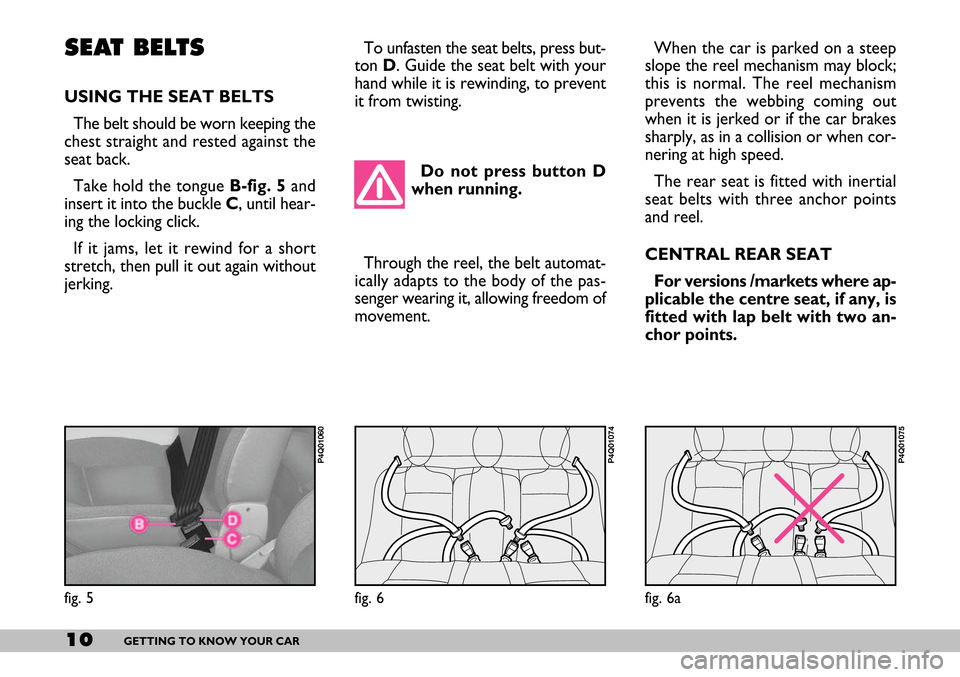
10GETTING TO KNOW YOUR CAR
fig. 6
P4Q01074
fig. 6a
P4Q01075
When the car is parked on a steep
slope the reel mechanism may block;
this is normal. The reel mechanism
prevents the webbing coming out
when it is jerked or if the car brakes
sharply, as in a collision or when cor-
nering at high speed.
The rear seat is fitted with inertial
seat belts with three anchor points
and reel.
CENTRAL REAR SEAT
For versions /markets where ap-
plicable the centre seat, if any, is
fitted with lap belt with two an-
chor points. To unfasten the seat belts, press but-
ton D. Guide the seat belt with your
hand while it is rewinding, to prevent
it from twisting.SEAT BELTS
USING THE SEAT BELTS
The belt should be worn keeping the
chest straight and rested against the
seat back.
Take hold the tongue B-fig. 5and
insert it into the buckle C, until hear-
ing the locking click.
If it jams, let it rewind for a short
stretch, then pull it out again without
jerking.
fig. 5
P4Q01060
Do not press button D
when running.
Through the reel, the belt automat-
ically adapts to the body of the pas-
senger wearing it, allowing freedom of
movement.
Page 12 of 154
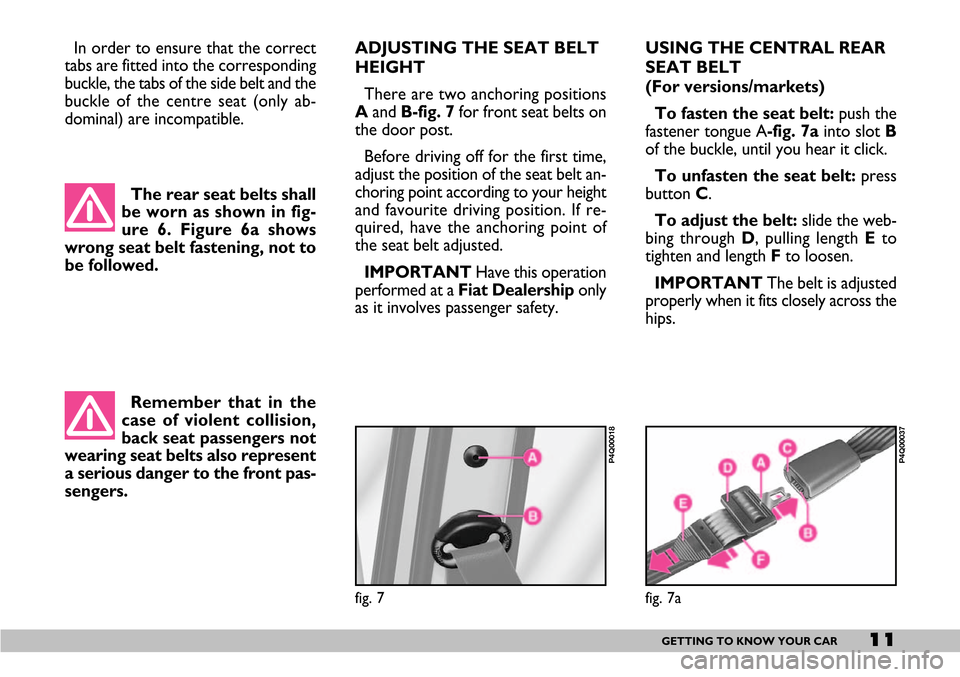
The rear seat belts shall
be worn as shown in fig-
ure 6. Figure 6a shows
wrong seat belt fastening, not to
be followed.
11GETTING TO KNOW YOUR CAR
fig. 7
P4Q00018
Remember that in the
case of violent collision,
back seat passengers not
wearing seat belts also represent
a serious danger to the front pas-
sengers.
ADJUSTING THE SEAT BELT
HEIGHT
There are two anchoring positions
A and B-fig. 7 for front seat belts on
the door post.
Before driving off for the first time,
adjust the position of the seat belt an-
choring point according to your height
and favourite driving position. If re-
quired, have the anchoring point of
the seat belt adjusted.
IMPORTANT Have this operation
performed at a Fiat Dealership only
as it involves passenger safety.USING THE CENTRAL REAR
SEAT BELT
(For versions/markets)
To fasten the seat belt:push the
fastener tongue A-fig. 7ainto slot B
of the buckle, until you hear it click.
To unfasten the seat belt:press
button C.
To adjust the belt:slide the web-
bing through D, pulling length Eto
tighten and length Fto loosen.
IMPORTANTThe belt is adjusted
properly when it fits closely across the
hips.
fig. 7a
P4Q00037
In order to ensure that the correct
tabs are fitted into the corresponding
buckle, the tabs of the side belt and the
buckle of the centre seat (only ab-
dominal) are incompatible.
Page 13 of 154

12GETTING TO KNOW YOUR CAR
AIRBAGPRETENSIONERS
AND
CLOCK SPRING2019
07
2018 2017
01 02 03 04 05 06
08 09 10 11 122015
07
2014 2013
01 02 03 04 05 06
08 09 10 11 12
ATTENZIONE:
CAUTION:
ACHTUNG: ATTENTION:
fig. 7b
P4Q00226
Operations which lead
to knocks, vibrations or
localised heating (over
100°C for a maximum of 6
hours) in the area around the
pretensioners may cause damage
or trigger them. These devices
are not affected by vibrations
caused by irregularities of the
road surface or low obstacles
such as kerbs, etc. Contact a Fiat
Dealership for any assistance.A small amount of smoke may be
produced. This smoke is in no way
toxic and presents no fire hazard.
The pretensioner does not require
any maintenance or greasing. Anything
that modifies its original conditions in-
validates its efficiency. If due to unusual
natural events (floods, sea storms,
etc.) the device has been affected by
water and mud, it must necessarily be
replaced.
The pretensioner can
only be used once.
After a collision that has
triggered it, have it replaced at
a Fiat Dealership. The validity of
the device is written on the plate
located on the front left door
post. The pretensioners should
be replaced at a Fiat Dealership
as this date approaches..PRETENSIONERS
To increase the efficiency of the front
and rear (where provided) seat belts,
the Fiat Panda is fitted with preten-
sioners. These devices “feel”, through
a sensor, that a violent crash is in
progress and rewind the seat belts a
few centimetres. In this way they en-
sure that the seat belt adheres per-
fectly to the wearer before the re-
straining action begins.
The seat belt locks to indicate that
the device has intervened; the seat belt
cannot be drawn back up even when
guiding it manually.
IMPORTANTTo obtain the high-
est degree of protection from the ac-
tion of the pretensioning device, wear
the seat belt keeping it firmly close to
the chest and pelvis.
Page 14 of 154

If the belt has been sub-
jected to heavy stress, for
example after an acci-
dent, it should be changed com-
pletely together with the an-
chors, anchor fastening screws
and the pretensioners. In fact,
even if the belt has no visible de-
fects, it could have lost its re-
silience.
13GETTING TO KNOW YOUR CAR
fig. 8
P4Q00038
For maximum safety,
keep the back of your
seat upright, lean back
into it and make sure the seat
belt fits closely across your chest
and hips.
Make sure that the seat belts of
the front and rear passengers are
fastened at all times! You in-
crease the risk of serious injury
or death in a collision if you
travel with the belts unfastened.
The belt should not be
twisted, make sure that it
is taut and adheres to the
passenger’s body. The upper part
should pass over the shoulder
and cross the chest diagonally.
The lower part should adhere to
the pelvis and to the abdomen of
the passenger, to prevent the
risk of slipping forwards, fig. 8.
Do not use any objects (pegs,
stoppers, etc.) to keep the belts
away from the body.Under no circumstances
should the components
of the pretensioner be
tampered with or removed. Any
operation should be carried out
by qualified and authorised per-
sonnel. Always contact a Fiat
Dealership.GENERAL INSTRUCTIONS
FOR USING THE SEAT BELTS
The driver must comply with (and
have the vehicle occupants follow) all
the local legal regulations concerning
the use of seat belts.
Always fasten the seat belts before
starting driving.
Page 15 of 154
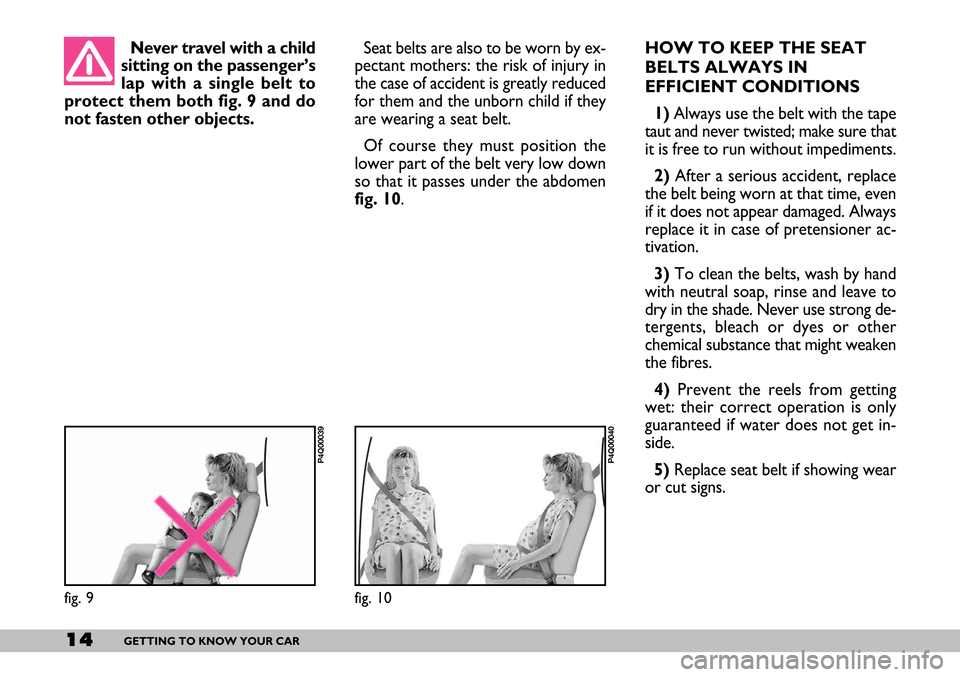
14GETTING TO KNOW YOUR CAR
Seat belts are also to be worn by ex-
pectant mothers: the risk of injury in
the case of accident is greatly reduced
for them and the unborn child if they
are wearing a seat belt.
Of course they must position the
lower part of the belt very low down
so that it passes under the abdomen
fig. 10.
fig. 10
P4Q00040
Never travel with a child
sitting on the passenger’s
lap with a single belt to
protect them both fig. 9 and do
not fasten other objects.
fig. 9
P4Q00039
HOW TO KEEP THE SEAT
BELTS ALWAYS IN
EFFICIENT CONDITIONS
1)Always use the belt with the tape
taut and never twisted; make sure that
it is free to run without impediments.
2)After a serious accident, replace
the belt being worn at that time, even
if it does not appear damaged. Always
replace it in case of pretensioner ac-
tivation.
3)To clean the belts, wash by hand
with neutral soap, rinse and leave to
dry in the shade. Never use strong de-
tergents, bleach or dyes or other
chemical substance that might weaken
the fibres.
4)Prevent the reels from getting
wet: their correct operation is only
guaranteed if water does not get in-
side.
5)Replace seat belt if showing wear
or cut signs.
Page 16 of 154
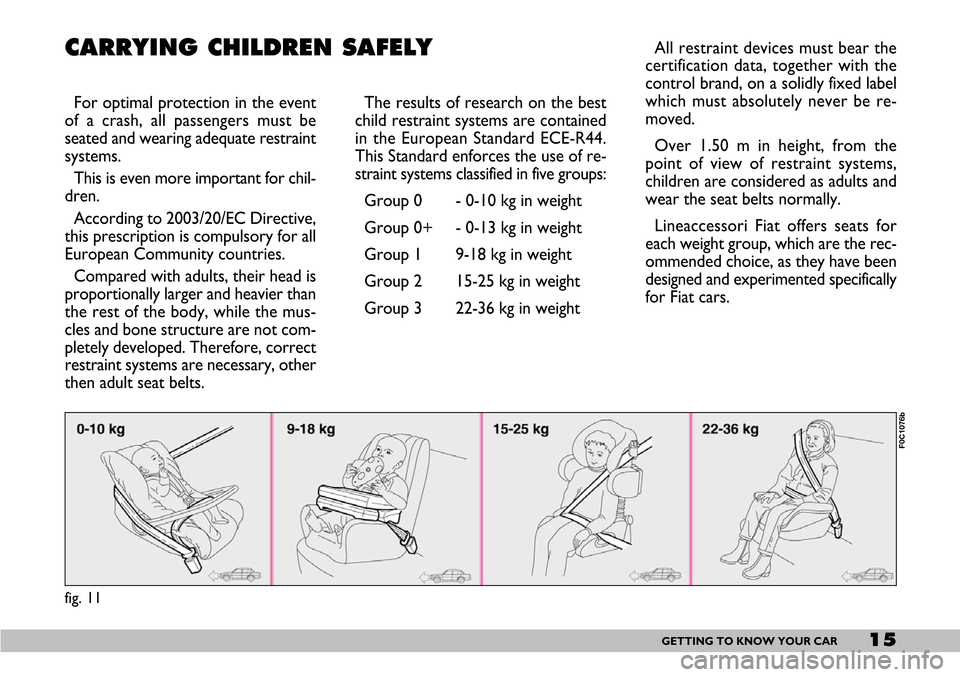
15GETTING TO KNOW YOUR CAR
fig. 11
F0C1076b
CARRYING CHILDREN SAFELY
For optimal protection in the event
of a crash, all passengers must be
seated and wearing adequate restraint
systems.
This is even more important for chil-
dren.
According to 2003/20/EC Directive,
this prescription is compulsory for all
European Community countries.
Compared with adults, their head is
proportionally larger and heavier than
the rest of the body, while the mus-
cles and bone structure are not com-
pletely developed. Therefore, correct
restraint systems are necessary, other
then adult seat belts.The results of research on the best
child restraint systems are contained
in the European Standard ECE-R44.
This Standard enforces the use of re-
straint systems classified in five groups:
Group 0 - 0-10 kg in weight
Group 0+ - 0-13 kg in weight
Group 1 9-18 kg in weight
Group 2 15-25 kg in weight
Group 3 22-36 kg in weightAll restraint devices must bear the
certification data, together with the
control brand, on a solidly fixed label
which must absolutely never be re-
moved.
Over 1.50 m in height, from the
point of view of restraint systems,
children are considered as adults and
wear the seat belts normally.
Lineaccessori Fiat offers seats for
each weight group, which are the rec-
ommended choice, as they have been
designed and experimented specifically
for Fiat cars.
Page 17 of 154
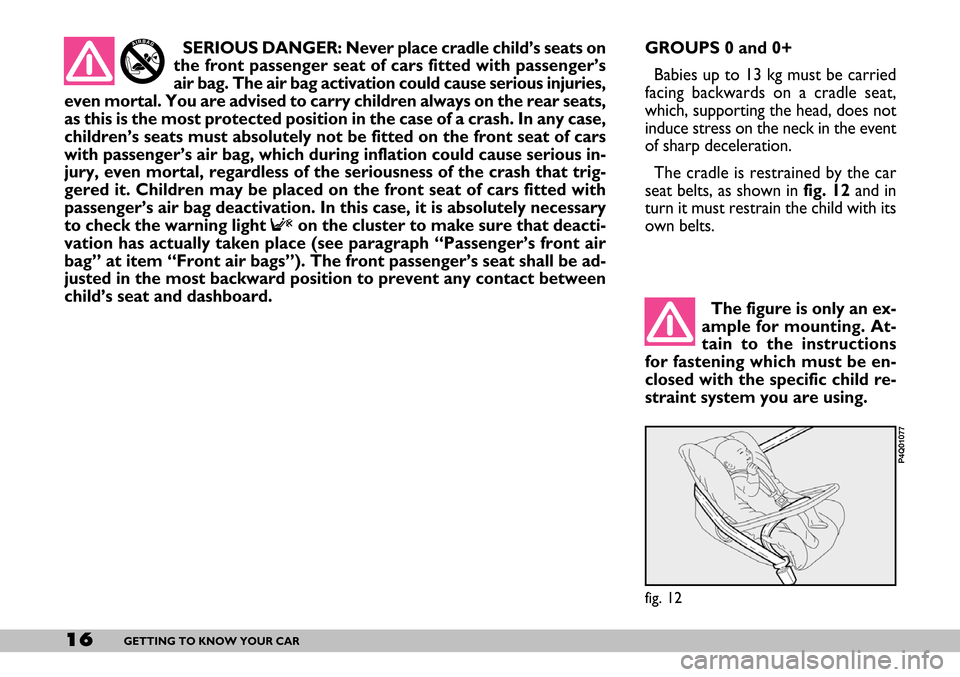
16GETTING TO KNOW YOUR CAR
fig. 12
P4Q01077
The figure is only an ex-
ample for mounting. At-
tain to the instructions
for fastening which must be en-
closed with the specific child re-
straint system you are using.
GROUPS 0 and 0+
Babies up to 13 kg must be carried
facing backwards on a cradle seat,
which, supporting the head, does not
induce stress on the neck in the event
of sharp deceleration.
The cradle is restrained by the car
seat belts, as shown infig. 12and in
turn it must restrain the child with its
own belts. SERIOUS DANGER: Never place cradle child’s seats on
the front passenger seat of cars fitted with passenger’s
air bag. The air bag activation could cause serious injuries,
even mortal. You are advised to carry children always on the rear seats,
as this is the most protected position in the case of a crash. In any case,
children’s seats must absolutely not be fitted on the front seat of cars
with passenger’s air bag, which during inflation could cause serious in-
jury, even mortal, regardless of the seriousness of the crash that trig-
gered it. Children may be placed on the front seat of cars fitted with
passenger’s air bag deactivation. In this case, it is absolutely necessary
to check the warning light
Fon the cluster to make sure that deacti-
vation has actually taken place (see paragraph “Passenger’s front air
bag” at item “Front air bags”). The front passenger’s seat shall be ad-
justed in the most backward position to prevent any contact between
child’s seat and dashboard.
Page 18 of 154
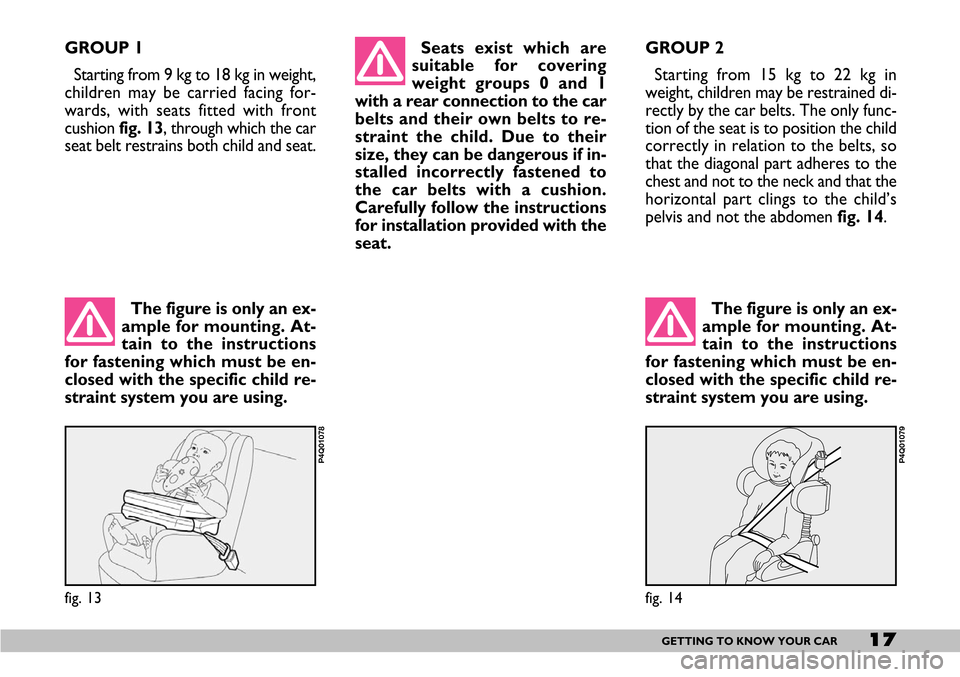
17GETTING TO KNOW YOUR CAR
fig. 13
P4Q01078
The figure is only an ex-
ample for mounting. At-
tain to the instructions
for fastening which must be en-
closed with the specific child re-
straint system you are using.
GROUP 1
Starting from 9 kg to 18 kg in weight,
children may be carried facing for-
wards, with seats fitted with front
cushion fig. 13, through which the car
seat belt restrains both child and seat.Seats exist which are
suitable for covering
weight groups 0 and 1
with a rear connection to the car
belts and their own belts to re-
straint the child. Due to their
size, they can be dangerous if in-
stalled incorrectly fastened to
the car belts with a cushion.
Carefully follow the instructions
for installation provided with the
seat.
fig. 14
P4Q01079
The figure is only an ex-
ample for mounting. At-
tain to the instructions
for fastening which must be en-
closed with the specific child re-
straint system you are using.
GROUP 2
Starting from 15 kg to 22 kg in
weight, children may be restrained di-
rectly by the car belts. The only func-
tion of the seat is to position the child
correctly in relation to the belts, so
that the diagonal part adheres to the
chest and not to the neck and that the
horizontal part clings to the child’s
pelvis and not the abdomen fig. 14.
Page 19 of 154
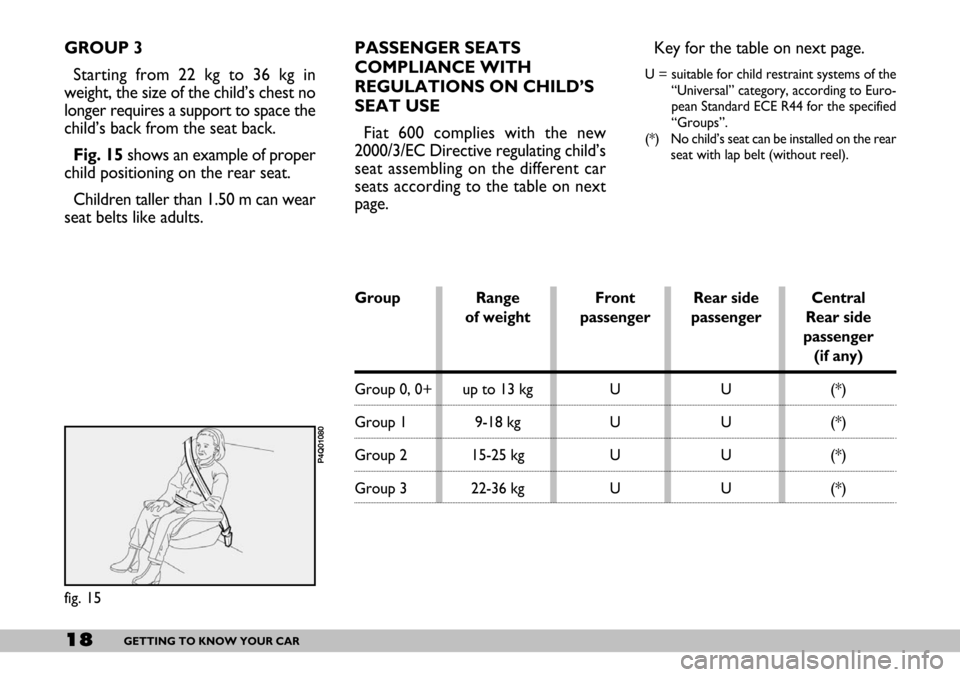
18GETTING TO KNOW YOUR CAR
Group Range Front Rear side Central
of weight passenger passenger Rear side
passenger
(if any)
Group 0, 0+ up to 13 kg U U (*)
Group 1 9-18 kg U U (*)
Group 2 15-25 kg U U (*)
Group 3 22-36 kg U U (*)
fig. 15
P4Q01080
GROUP 3
Starting from 22 kg to 36 kg in
weight, the size of the child’s chest no
longer requires a support to space the
child’s back from the seat back.
Fig. 15shows an example of proper
child positioning on the rear seat.
Children taller than 1.50 m can wear
seat belts like adults.PASSENGER SEATS
COMPLIANCE WITH
REGULATIONS ON CHILD’S
SEAT USE
Fiat 600 complies with the new
2000/3/EC Directive regulating child’s
seat assembling on the different car
seats according to the table on next
page.Key for the table on next page.
U = suitable for child restraint systems of the
“Universal” category, according to Euro-
pean Standard ECE R44 for the specified
“Groups”.
(*) No child’s seat can be installed on the rear
seat with lap belt (without reel).
Page 20 of 154
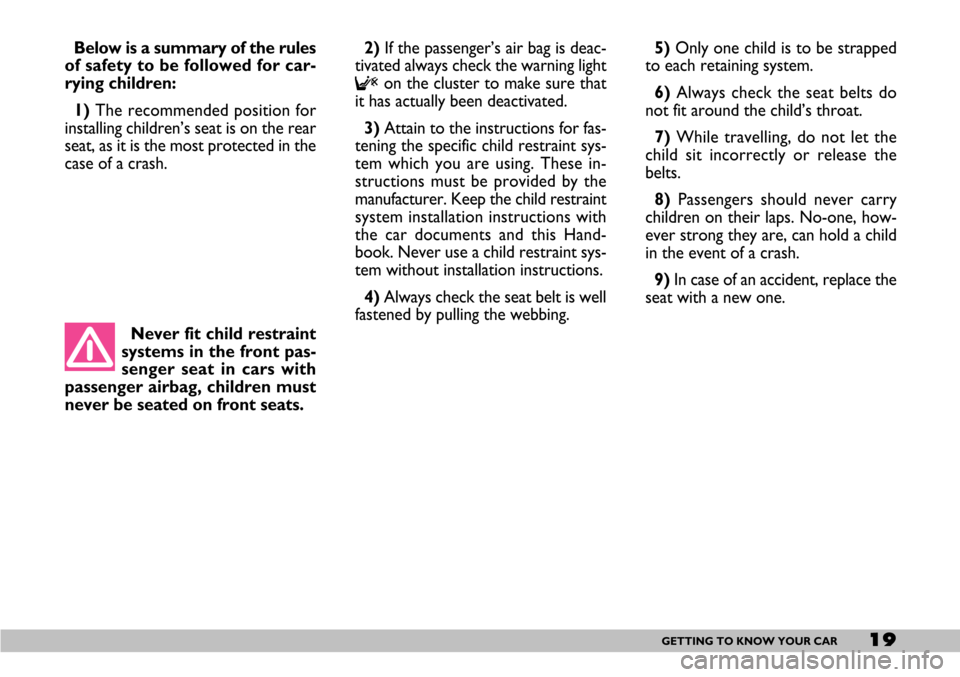
19GETTING TO KNOW YOUR CAR
Below is a summary of the rules
of safety to be followed for car-
rying children:
1) The recommended position for
installing children’s seat is on the rear
seat, as it is the most protected in the
case of a crash.
Never fit child restraint
systems in the front pas-
senger seat in cars with
passenger airbag, children must
never be seated on front seats.2) If the passenger’s air bag is deac-
tivated always check the warning light
Fon the cluster to make sure that
it has actually been deactivated.
3) Attain to the instructions for fas-
tening the specific child restraint sys-
tem which you are using. These in-
structions must be provided by the
manufacturer. Keep the child restraint
system installation instructions with
the car documents and this Hand-
book. Never use a child restraint sys-
tem without installation instructions.
4) Always check the seat belt is well
fastened by pulling the webbing.5) Only one child is to be strapped
to each retaining system.
6) Always check the seat belts do
not fit around the child’s throat.
7) While travelling, do not let the
child sit incorrectly or release the
belts.
8) Passengers should never carry
children on their laps. No-one, how-
ever strong they are, can hold a child
in the event of a crash.
9) In case of an accident, replace the
seat with a new one.